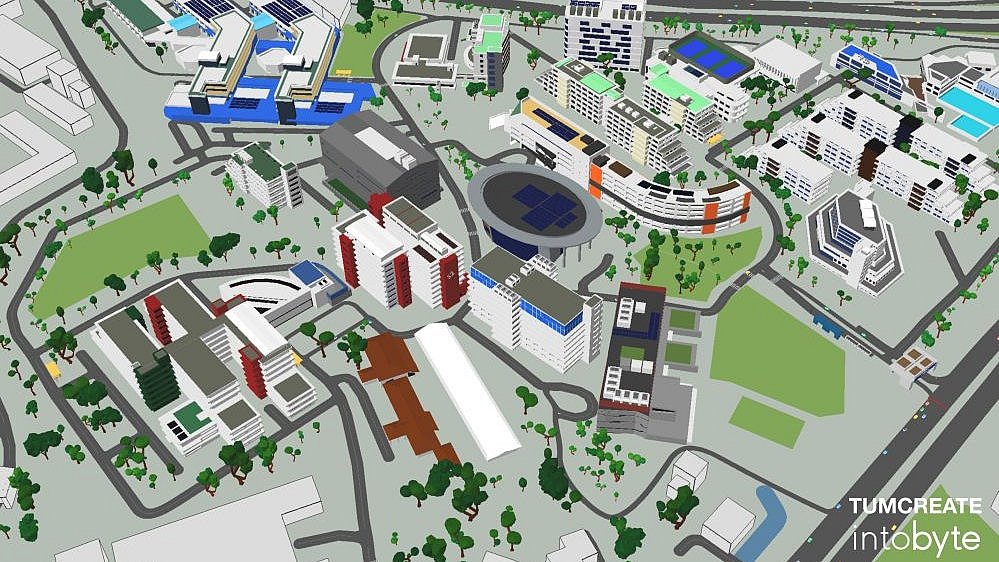Planning traffic in cities with precise models
Smart simulations for urban mobility

We go shopping, to work, or on vacation. Trains transport goods over long distances; trucks supply construction sites with new materials or stores with goods. Mobility is a basic human need and also an important global factor. However, intersections and road layouts are different at every location. When traffic and road planners conceive new projects, such as the electrification of local transport, the implementation must be tailored accordingly.
This is where digital models become very helpful. Researchers at TUM have developed the “City Mobility Simulator” (CityMoS) software, which enables them to create and calculate detailed simulations of entire cities —on standard computers.
CityMoS was developed in Singapore at “TUMCREATE”, a multidisciplinary research platform. This is TUM’s research facility on the “Campus for Research Excellence and Technological Enterprise” (CREATE), with most of its research being funded by the National Research Foundation Singapore. TUMCREATE collaborates with partner universities such as Nanyang Technological University (NTU), public and private research institutions, as well as industry partners. With its study campus TUM Asia, TUM has been present in Singapore since 2002.
For almost 10 years, in Singapore, Dr. David Eckhoff has been the lead scientist responsible for the simulator in various projects. “Traffic is a result of mobility, and as different as villages or cities are, so are the requirements for traffic planning,” he explains. “Our simulator can respond to this very well.”
Parallel computing for accuracy at scale
Simulations of larger areas, such as entire cities, are usually based on mathematical formulas or simplified movement models. Then there are also microscopic models, i.e. very precise representations in which the behavior of each vehicle, such as its detailed acceleration, braking and lane-changing behavior is depicted. Because this level of detail requires a lot of computing power, such high-resolution simulations could previously only be used for smaller areas such as intersections or city districts.
This is where CityMoS comes in: David Eckhoff and his team have developed their smart simulation tool so that all computer processors are used simultaneously and efficiently to carry out a simulation. As a result, detailed simulations of entire cities and their traffic can be created on regular computers. The software can also simulate several aspects of mobility simultaneously: It analyzes commuter behavior, considers public transport, and even includes charging behavior for electric vehicles—in other words, it encompasses all mobility factors, not just traffic.
The wide range of applications for CityMoS gave David Eckhoff and two of his colleagues the idea to make their product commercially available. In 2020, they founded “intobyte” in Singapore. They now have customers in both Asia and Europe using their services and software.
Data quality crucial for simulation
Since 2012, the city-state of Singapore has been the first testing ground for the simulator. At that time, the TUMCREATE scientists working on the project were under the direction of Prof. Alois Knoll from the TUM Chair of Robotics, Artificial Intelligence, and Embedded Systems. Now, a complete digital twin of the city exists, which is being used to investigate various issues: Where do charging stations need to be located for the electrification of freight and commercial traffic? What needs to be considered when electrifying bus fleets? When and how much electricity must be planned for vehicle charging?
Regardless of which questions the tool helps to answer, the underlying data is always crucial. “If only incomplete or inaccurate data is available, then there’s a risk that a simulation is not meaningful. Data is the basis for intelligent solutions - fortunately, a lot has happened in this area in the last 10 years,” says Eckhoff.
Data can come from various sources: from commercial partners such as car manufacturers, from smart traffic lights, from government agencies, or citizen surveys. Singapore is an ideal location for researchers: The national Land Transport Authority makes much data publicly available in its “DataMall,” which helps researchers model the city.
Research platform for international exchange
Researchers at TUMCREATE also benefit from branches of the world's leading research institutions, such as the Massachusetts Institute of Technology (MIT), the University of Cambridge, and ETH Zurich, located on the same campus. “We have short distances here on the CREATE Campus, which makes collaborations with top scientists very easy,” says Dr. Eckhoff. “For young researchers working here, this is a great opportunity to build up their scientific network and to work on cutting-edge research questions.”
The article was already published on the website "Research in Bavaria" of the Bavarian State Ministry of Science and Arts:
https://www.research-in-bavaria.de/smart-simulations-for-urban-mobility/
Technical University of Munich
Corporate Communications Center
- Vera Spaett
- vera.spaett@tum.de
- presse@tum.de
- Teamwebsite



